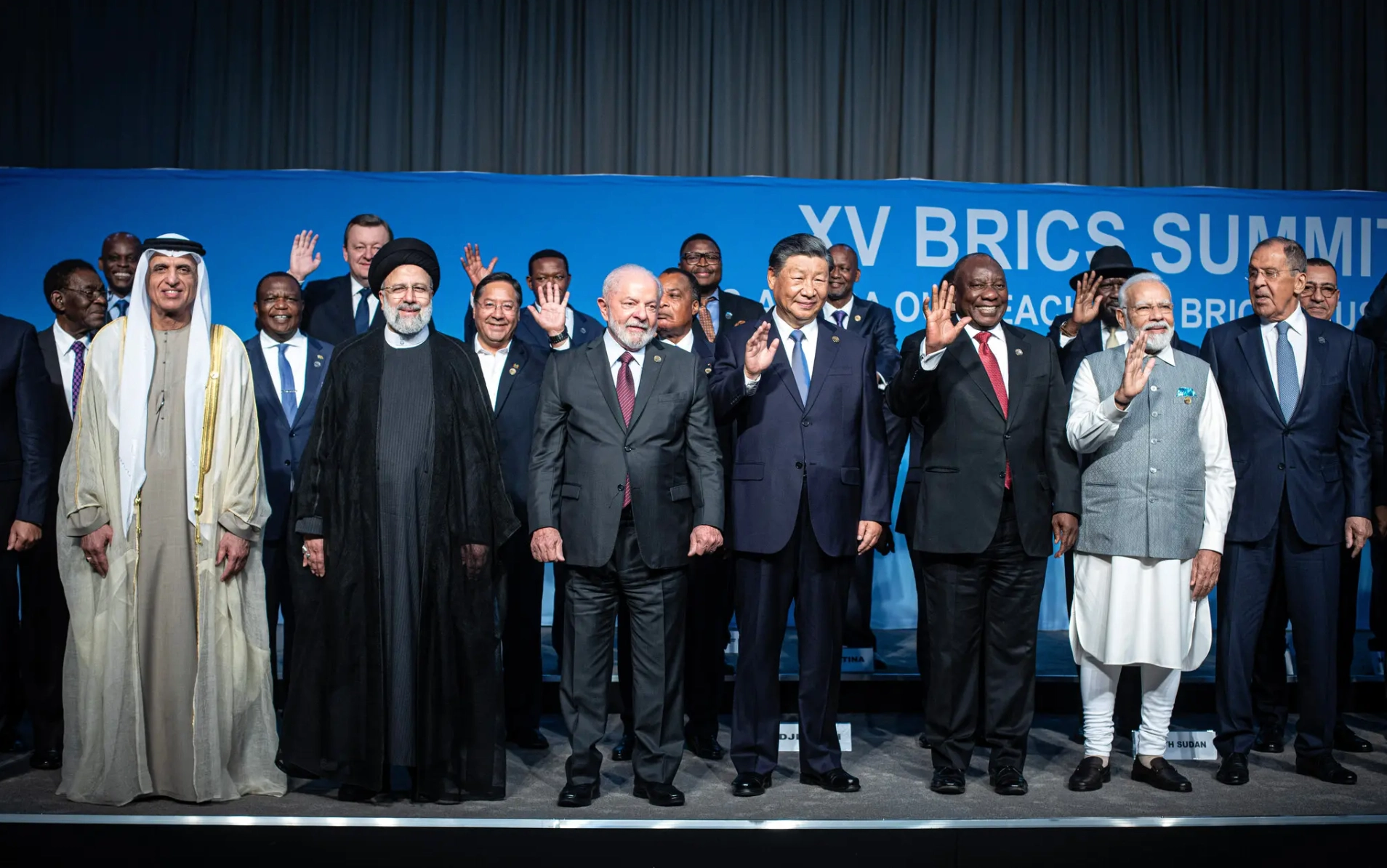
The BRICS group – originally Brazil, Russia, India, China, and South Africa – is currently going through an outstanding political moment. At the recent Summit in South Africa, the group formalized its invitation to six new members: Argentina, Saudi Arabia, Egypt, the United Arab Emirates, Ethiopia, and Iran. This consolidates the geopolitical character of the BRICS, as they include, on the one hand, a historical ally of the United States in the Middle East, Saudi Arabia, and, on the other hand, Iran, which is suffering from U.S. sanctions. China has recently mediated the resumption of diplomatic relations between the two.
The BRICS have constituted themselves as a political and economic platform since the late 2000s. Their rise reinforced the entrenched imaginary of “modernization” and “development” in the Global South, giving rise to optimism about the ability of these countries to become an alternative to Western hegemony. Today, tensions – and expectations – about the international role of the BRICS have grown in the geopolitical sphere. From a historical point of view, it is important for Latin America and Africa to support the diversification of economic partnerships that can counterbalance the omnipresence of the United States and Europe.
We can analyze the BRICS from at least three dimensions. The first is the “top-down view”, when we analyze the international system as an environment formed by relatively cohesive nation states with a national interest that seek to preserve or increase their power in an environment of competition among themselves. This approach is confused with the geopolitical analyses of the BRICS. From this perspective, the BRICS seek to accumulate economic, political and military capabilities vis-à-vis the traditional powers, particularly the United States and Europe.
At their inception, in the context of the 2008 financial crisis, the BRICS sought to act in a coordinated manner in multilateral fora to call for reforms in the institutions of global economic and political governance, especially the International Monetary Fund and the World Bank, but also (by Brazil and India) in the UN Security Council. This reformist agenda has been a point of tension with the Western powers, which have tried to delay or even prevent such reforms in institutions created in the post-war period, arousing the expectations of some social segments about the “counter-hegemonic” potential of the BRICS.
International security issues were already gaining ground at each BRICS Summit. However, geopolitical tensions gained prominence with the election of Donald Trump in the United States in 2017, when the U.S. focused its attention on containing China’s technological expansion. In 2022, with the Russian invasion of Ukraine, the world was once again represented as “West versus East,” and the China-Russia alliance, within the BRICS, definitively set the geopolitical, rather than economic, tone of the grouping. From this perspective, the group is increasingly becoming a geopolitical rather than an economic alliance.
Another way of looking at the BRICS is from a “horizontal” (or lateral) perspective, i.e., analyzing intra-bloc relations, trying to identify convergences and asymmetries among countries. Considering the health sector, for example, the BRICS have tried to increase their cooperation, establishing working groups and memoranda of understanding. At the same time, the pandemic tested cooperation, and the BRICS countries did not coordinate a joint position on the temporary relaxation of vaccine patents in World Trade Organization discussions.
In previous work, we showed that there are economic asymmetries between the countries, given the economic preponderance of China. In trade relations, for example, three of the BRICS countries – Brazil, Russia, and South Africa – maintain trade surpluses with China, but their exports consist mainly of agricultural products and primary minerals: soybeans, iron ore, crude and refined oil, coal, manganese and other hydrocarbons. India, the only BRICS country with a trade deficit with China, also tends to export primary products to its Asian partner, as well as medicines. China’s intra-BRICS exports consist of telephone parts, data processing machines, and semiconductors. In this sense, intra-BRICS trade relations can be traced back to the traditional international division of labor, with China at its center. This asymmetric interdependence tends to perpetuate the deindustrialization of the Brazilian economy in the medium term, as Brazil has lost its place to China as the main exporter of manufactured goods to other South American countries.
A third way of analyzing the BRICS is based on their relations with other developing countries and regions in Africa, Asia, and Latin America. This would be a “vertical” (or bottom-up) view, as each BRICS country acts as a regional power seeking to influence and accumulate economic power with others on the “periphery”. At times, the actions of the large BRICS multinational companies in Africa and Latin America reproduce practices of exploitation of raw materials, labor, and natural resources, generating new cycles of accumulation and expropriation. According to experts, China’s economic influence in Africa has led to a reformulation of intra-African relations: instead of the ideas of Pan-Africanism, these relations are now portrayed through the lens of the “Global South” and “South-South Cooperation”, this being a narrative that brings Chinese interests to the continent.
For his part, expert Carmody (2015) argues that South African and Chinese capital generally work together to exploit natural resources and dominate markets in Africa. In both Africa and Latin America, some analyze relations with China as unequal and dependent on trade and investment, which serve to guarantee the Asian country’s supply of raw materials and promote the opening of markets for the sale of high-tech products and services by Chinese companies.
For Brazil, this is a time of opportunities and challenges. A strong and expanded BRICS is good for Brazil as a founding member of the bloc and a regional leader in South America. At the same time, the group is increasing its strong economic base in fossil fuels, as well as a larger democratic deficit, challenging Brazil as it seeks, on the one hand, to be a protagonist in climate negotiations and push for a just energy transition and, on the other hand, to spread ideas of democracy and social rights, as the current Lula government intends to do. The country must maintain its relative autonomy in the face of international tensions between the powers and negotiate better conditions in intra-BRICS relations. South-South technology transfer and effective cooperation in areas such as health, environment, agriculture, and energy are fundamental to achieving better social living and working conditions for the majority of our population.
*Translated by Janaína Ruviaro da Silva from the original in Portuguese.


